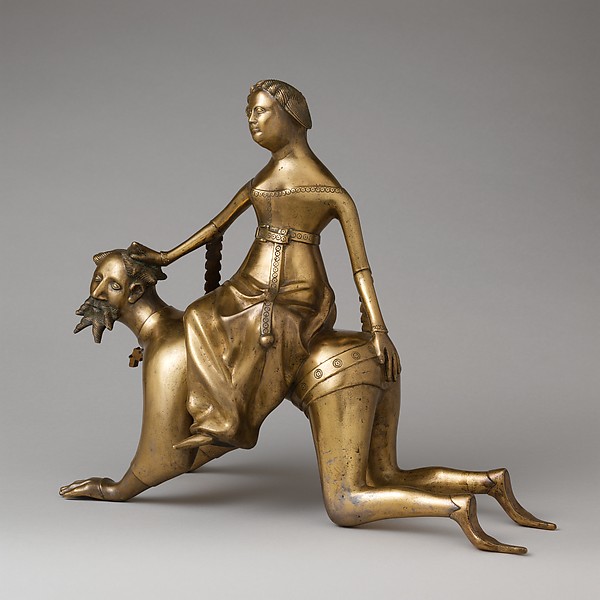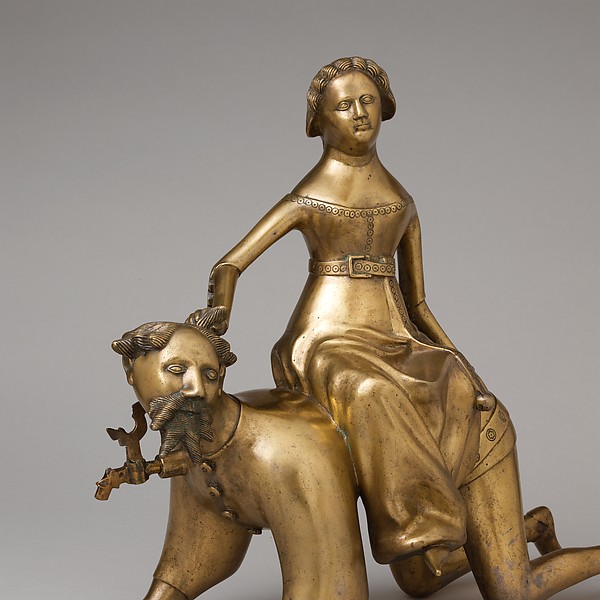There is an apocryphal story about Aristotle and Phyllis,
the consort of Alexander the Great, that goes back to the Middle Ages, though
its exact origins are unclear. The tale relates that the philosopher, having
cautioned his pupil, Alexander, to avoid spending too much time on the carnal
delights of his mistress, was in turn beguiled by the lady, who resented his
intrusion. He became so infatuated with her that he eventually propositioned
her, but she denied him, saying that unless he could prove his love was not
just lust, she would have none of him. She demanded that to demonstrate his
devotion, he come crawling on hands and knees to her bedchamber, where she
would ride him like a horse. He complied. Phyllis then ratted the old fellow
out to Alex, who threatened to kill him, but being canny (and this being a
moralizing exemplum), Aristotle retorted something to the effect of, “If an
old, wise man such as myself can be so deceived by woman’s wiles, then all the
more reason a young man such as yourself should be wary.” We don’t hear what
happened to the “devious” Phyllis.
As a woman, I feel some sympathy for her – this horny old
guy, a sort of echt-creepy-professor type, not only cautions her boyfriend off
her, but then tries for some grabass himself. Her scheme is perfect in its
irony – playing on the expectation of female lustiness and sinfulness, she exposes
masculine lust.
This little copper alloy aquamanile (hand-washing pitcher)
from the southern Netherlands, ca. 1400 captures the piquant erotics of the
tale nicely. Phillys is so pretty and willowy in her low-cut gown with its
stylish, fluttering sleeves, and Aristotle wears an expression at once forlorn
and goofily blissful as he strikes his posture of servitude. Her touch on his
head is almost fond, as if she is stroking his wiry hair, the way one might pet
the mane of one’s favorite horse. But the hand on his derrière is less
innocent. 

 Whether she is spanking him or simply goosing him, it’s an intrusive,
sexual, and transgressive gesture. Especially so when one picks up the pitcher
by its handle (her arm) and lifts his posterior high into the air in order to
pour water from the spout, which projects from Aristotle’s chest. Let’s not
forget, either, that Phyllis’ gown falls heavily over her relaxed legs,
delineating the spread of her thighs quite clearly, and Aristotle wears a
daringly short doublet and tight hose for an older gent (usually, the longer
the beard, the longer the robe).
Whether she is spanking him or simply goosing him, it’s an intrusive,
sexual, and transgressive gesture. Especially so when one picks up the pitcher
by its handle (her arm) and lifts his posterior high into the air in order to
pour water from the spout, which projects from Aristotle’s chest. Let’s not
forget, either, that Phyllis’ gown falls heavily over her relaxed legs,
delineating the spread of her thighs quite clearly, and Aristotle wears a
daringly short doublet and tight hose for an older gent (usually, the longer
the beard, the longer the robe).
The dance-like quality of this object proceeds from the way
it captures, in gesture, the entire essence of the story: the humiliations and
pleasure of desire, the perceived dominance and pretty cruelty of women, the
reduction of the sexually striving body to mute, manipulable materiality. Additionally
it is so clearly an object meant to be handled and to move in space (how else
would the water pour out?) and to be the lynchpin of a brief, but significant
ritual of secular life – one person pours, another washes hands. Even the
master/servant dialectic embedded in the narrative (and delightfully inverted
in Phyllis’ mastery of the Great Master) and in the object, plays with the
situation in which the pitcher would have been used; the servants pour, the masters
wash, but in manipulating the object, controlling the flow, the servants are
essentially in charge.
If I had any choreographic talent or opportunity (even
without the talent), I would take this object, and the tale to which it refers,
as a point of departure for a short ballet, three movements. The first has
three dancers, the lovers and the figure of wisdom who intrudes and attempts to
disrupt their idyll; music, Purcell’s overture to The Old Bachelor. The second explores the wisdom figure’s anguished
realization of desire, and is set to that plangent Monteverdi madrigal, Si dolce e’l tormento. And finally, the
seduction and exposure: Handel’s Lascia
ch’io piangia (which is musically in some ways a mirror image of the
Monteverdi), with a coda from the final section of The Old Bachelor.
But, since I’m unlikely ever to have the skill, time,
resources, or outlet for such a project, for now, I leave you with this, from
Mario Bigonzetti’s ballet, Caravaggio.
It’s more somber than what I have in mind, but the seventeenth-century music
and the pas-de-trois dynamic is right.
No comments:
Post a Comment